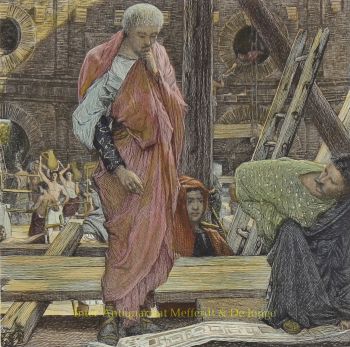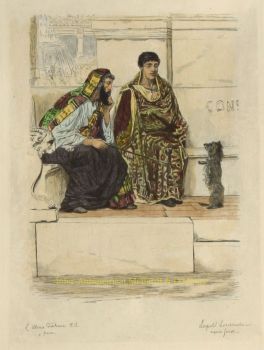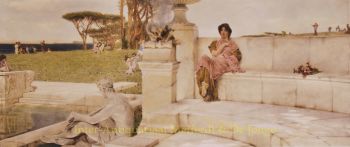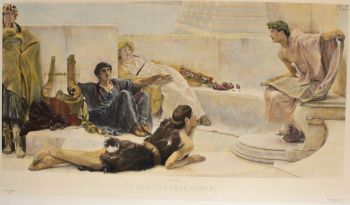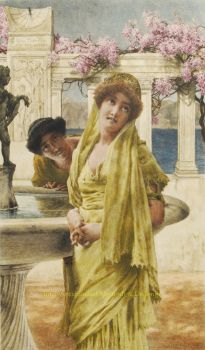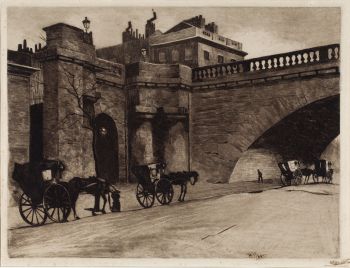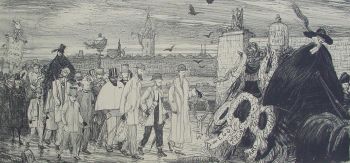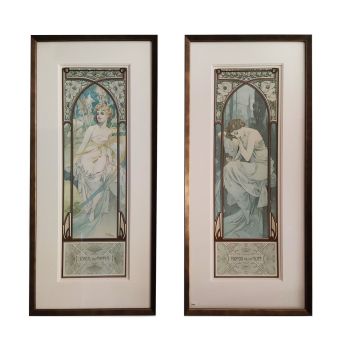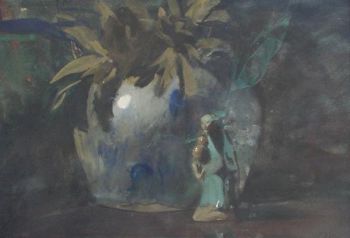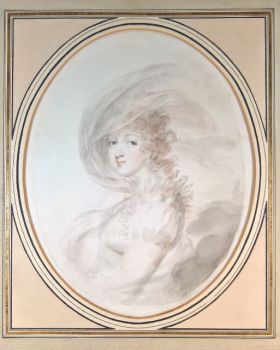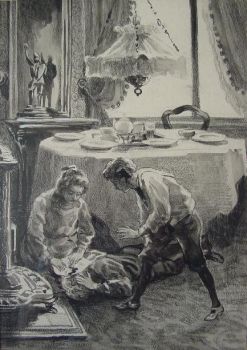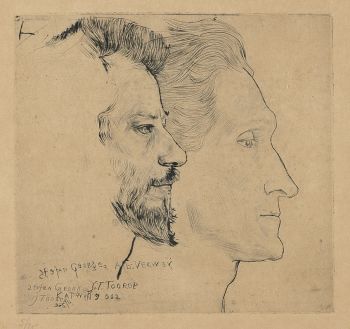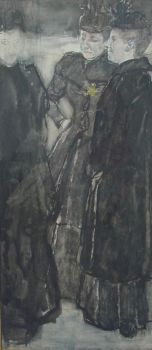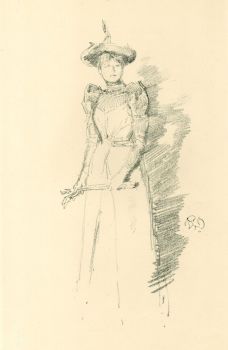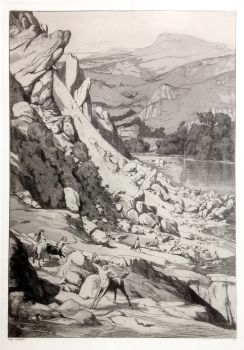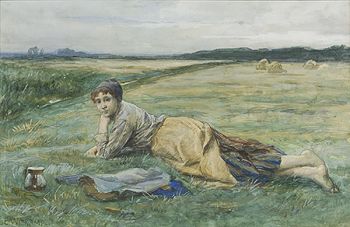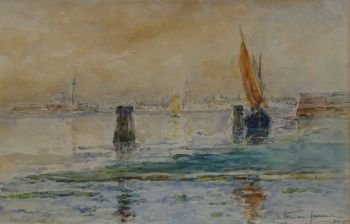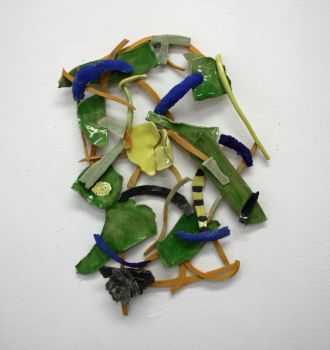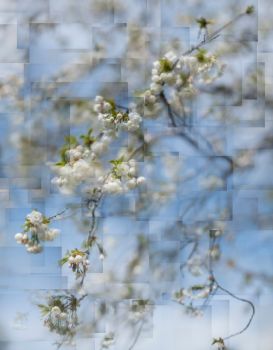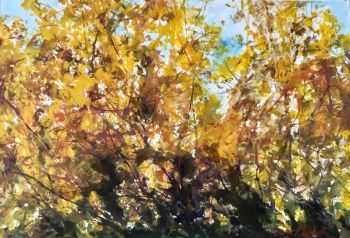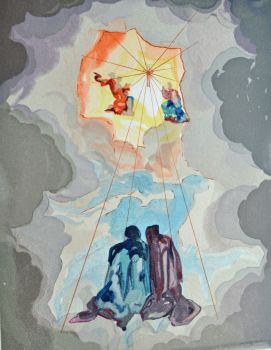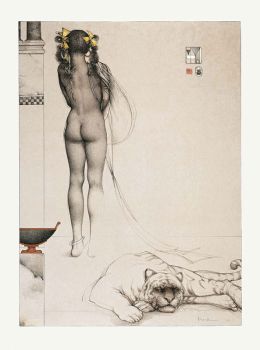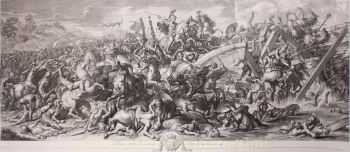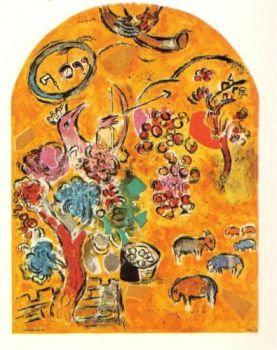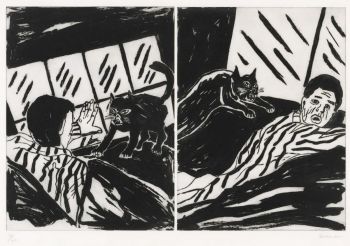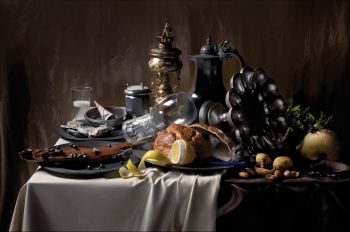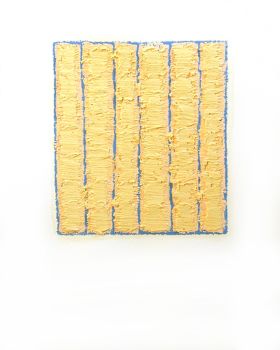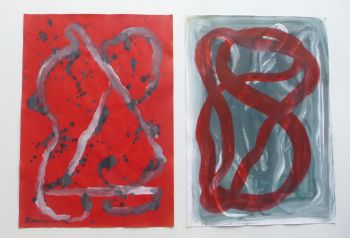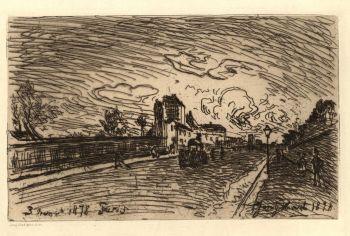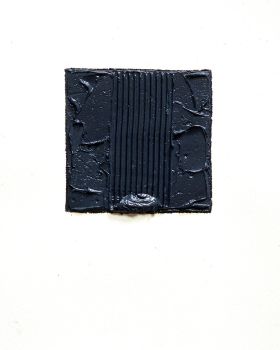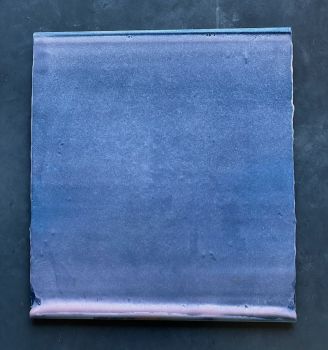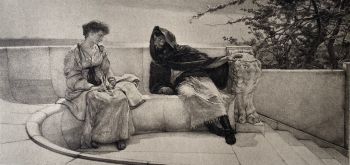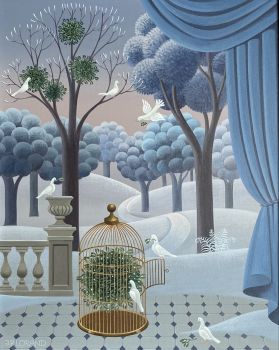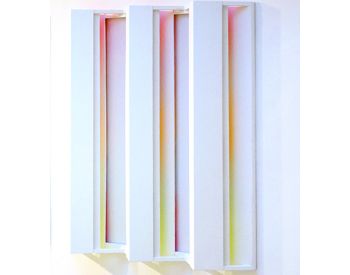Spring 1894
Lawrence Alma-Tadema
CartaStampaStampa fotografica
35 ⨯ 47 cm
ConditionVery good
€ 550
Gallerease Selected
- A proposito di opere d'arte
Original photogravure of the painting Spring from Sir Laurence Alma Tadema. Printed in 1894 on thick cream paper in a serie of 400 pieces by 'Photographische Gesellschaft' Image size: 15 cm by 25,5 cm Paperformat: 35 cm by 47 cm The original photogravure depics a procession of women and children descending marble stairs carry and wear brightly colored flowers. Cheering spectators fill the windows and roof of a classical building. Lawrence Alma-Tadema here represented the Victorian custom of sending children into the country to collect flowers on the morning of May 1, or May Day, but placed the scene in ancient Rome. In this way, he suggested the festival's great antiquity through architectural details, dress, sculpture, and even the musical instruments based on Roman originals. The painting was first put on display at the Royal Academy in 1895 and enjoyed great success. The picture's popularity continued over the next few years with prints very much in demand. After a memorial exhibition in 1913, the painting disappeared from the art scene, and it was not until 1970 that it made a comeback. It joined the collection of a certain Mr. Funt, an American TV personality/art collector, and it was subsequently purchased at auction by the Getty Museum in 1972. It was thought at the time to represent the realities of ancient Rome and it took pride of place in the Getty "Roman Villa" in 1974. The apparent authentic "Romanism" of the painting had even inspired certain scenes in Cecil B. De Mille's Hollywood production of "Cleopatra" of 1934. However, further research into the painting's subject and significance suggests it is more an idealised Victorian representation of spring, rather than a specific Roman festival. The scene, with a procession of young people, flowers and musical instruments, is a joyful springtime celebration. It has been likened to the Roman spring festivals: Floralia, Cerealia or Ambarvalia. The artist may have been inspired by descriptions of the spring festival in honour of Ceres or Flora as described by the Roman poet Ovid. It also corresponds to Victorian Mayday festivities, where young girls went out into the countryside and collected flowers, then carried them back in blithesome procession. Alma Tadema presents the scene as a parade in a festive jubilant setting, and it was something the people could relate to. Processions abounded in late Victorian England: receptions for visiting heads of state, royal weddings of Queen Victoria's children/grandchildren, and particularly for the queen's fifty, and then sixty, years of reign. Here, the backdrop is ancient Rome and the procession winds through shining marble passageways. Young girls carry pretty flowers or branches with buds or blossoms. Pipers are making music. Others follow carrying symbolic ritual items, including the bearers of a fine chalice, a casket and an ivory altar. Excited onlookers line the way. These beautifully detailed groups of figures and the surrounding Roman architecture are the key to the painting. Lawrence Alma Tadema was known for his glorious details; it is said that Alma Tadema compositions are the sum of his details. Looking closely, we behold richly ornamented columns and partial columns, full statues that replicate authentic Roman statues in silver and bronze, finely detailed nature elements, and above all, a dazzling feast of delicate yet vibrant spring flowers. The faithfully wrought architecture of this Tadema Rome has numerous columns, arches and balconies to seem almost like a stage set. Indeed, the artist had a background in creating grandiose stage sets for Shakespeare plays in the 1880s that amply satisfied the Victorian taste for spectacle. Against this stage-like background of white marble, and the pale, pastel clothing of the people, the strong bright colours of the flowers and garlands really stand out. The eye goes from one spot of colour to another, then, in the distance, to the red walls of the "royal box", where the viewer pauses to absorb a myriad of refined details. The impact of the picture is the contrast between vibrant colourful flowers and the stark white marble. It is the flowers that provide the most important detail, a detail that reflects the artist's well-known fondness for flowers. However, the flowers in the picture are not all Mayday blossoms; many were selected for their colours and symbolism rather than appropriateness of season. One last detail gives us an insight into the Roman period that Alma Tadema wanted to represent in his celebration of spring: the inscription and relief on the archway at centre left of the picture. The artist has reproduced the dedication sculpted on the Arch of Trajan in Benevento, near Rome, built to commemorate the opening of the Appian Way and completed during the reign of the Emperor Hadrian (reigned 117-138). This leads us to presume that the setting for Lawrence Alma Tadema's joyous "Spring" is Emperor Hadrian's prosperous Rome. Who says that art is a purely visual enjoyment? This gracious painting of "Spring" is full of fragrant air, you can almost smell the faint perfume of the darling buds of May, you can hear the light lilting music, you can feel the warming rays of the sun. "As the sun colours flowers, so art colours life". This was the artist's personal motto, and the idea is present in every Lawrence Alma Tadema composition. Originally from Holland, the young Lawrence, or Lourens as he was originally named, studied art at the Royal Academy of Antwerp. In 1870, he moved to England where he settled permanently in London. He adjusted his name to the more Britannic "Lawrence", and his Dutch origins are often overlooked. Alma-Tadema's paintings also enjoyed popularity later, when his large panoramic depictions of Greek and Roman life caught the attention of Hollywood. Certain scenes in Cecil B. DeMille's film Cleopatra (1934) were inspired by the painting Spring.
This photogravure is from the portfoliobook: "Laurence Alma Tadema, R.A. - A Sketch Of His Life And Work. With A Portrait, An Autograph, And Twenty-Two Illustrations." (London: Berlin Photographic Company) 1895, containing 22 reproductions of works by Tadema, including: a half title-page; a frontispiece showing the artist in his studio; another title-page with a printer's mark; a list of illustrations; a biography of the artist by F. G. Stephens; with head and tail-pieces; totale edition number of 400. Bound in cloth-covered binding inscribed with the title. - A proposito di opere artista
Lawrence Alma-Tadema è uno degli artisti romantici più famosi della Gran Bretagna della fine del XIX secolo. Nacque nei Paesi Bassi come Laurens Tadema, dalla famiglia del notaio della città. Più tardi, mentre cercava di fare la sua nicchia nel mondo dell'arte, cambiò l'ortografia del suo nome nel più inglese "Lawrence", e incluse il suo secondo nome "Alma" come parte del suo cognome, così sarebbe stato elencato tra le “A” nei cataloghi delle mostre.
Da bambino fu deciso che Alma-Tadema avrebbe intrapreso la carriera di avvocato, ma all'età di quindici anni ebbe un crollo mentale e fisico. Gli fu diagnosticato un tisico, gli fu dato poco tempo da vivere, e quindi libero di perseguire una vita di svago e piacere. Una volta lasciato a se stesso, decise di studiare arte, poiché sua madre aveva pagato lezioni d'arte nella sua prima infanzia ed era uno dei suoi interessi. Ha riguadagnato la sua salute e ha studiato alla Royal Academy of Antwerp nel 1852, dove ha vinto numerosi premi rispettati. La sua prima opera importante fu esposta nel 1858 e ottenne molti elogi dalla critica, creando scalpore nel mondo dell'arte.
Nel 1862, si mise in proprio nel suo studio per perseguire la sua carriera individuale nell'arte. Nel 1869, Alma-Tadema perse la moglie di sei anni a causa del vaiolo. Sconsolato e depresso, smise di dipingere e la sua salute cominciò a peggiorare. Su consiglio del suo medico, si recò in Inghilterra per una diagnosi medica, dove fu invitato a casa di un collega pittore, Ford Madox Brown. Fu qui che mise gli occhi su Laura Theresa Epps, che all'epoca aveva 17 anni, e se ne innamorò perdutamente. Alma-Tadema approfittò dello scoppio della guerra franco-prussiana per trasferirsi in Inghilterra, dove non perse tempo contattando Laura e assumendole lezioni private d'arte. Fu durante una di queste lezioni che Alma-Tadema propose, e poco dopo si sposarono. Alma-Tadema aveva 34 anni e la sposa 18.
Alma-Tadema trascorse la parte successiva della sua vita viaggiando attraverso l'Europa e godendosi il continuo successo dei suoi dipinti. Come uomo, le sue esplosioni di cattivo umore sono state alleviate dalla sua personalità estroversa e calda e dal suo senso di malizia. Perfezionista e lavoratore ossessivo, innovò anche una nuova tecnica di numerazione, che rendeva difficile ai falsari spacciare opere non originali. Nei suoi ultimi anni, sebbene la sua produzione artistica sia leggermente diminuita, ha goduto di un successo continuo, fino a diventare uno dei pittori più ricchi del XIX secolo. Fu nominato cavaliere in Inghilterra nel 1899.
Nel 1912, Alma-Tadema si recò in Germania per sottoporsi a cure per l'ulcera allo stomaco e morì in Germania all'età di 76 anni. Dopo la sua morte, il suo lavoro fu per lo più ignorato. A causa dei drastici cambiamenti in atto nell'arte, il genio artistico di Alma-Tadema non sarebbe tornato agli occhi del pubblico fino agli anni '60. Da allora il suo lavoro meticoloso è stato utilizzato come materiale di partenza per dozzine di film di Hollywood.
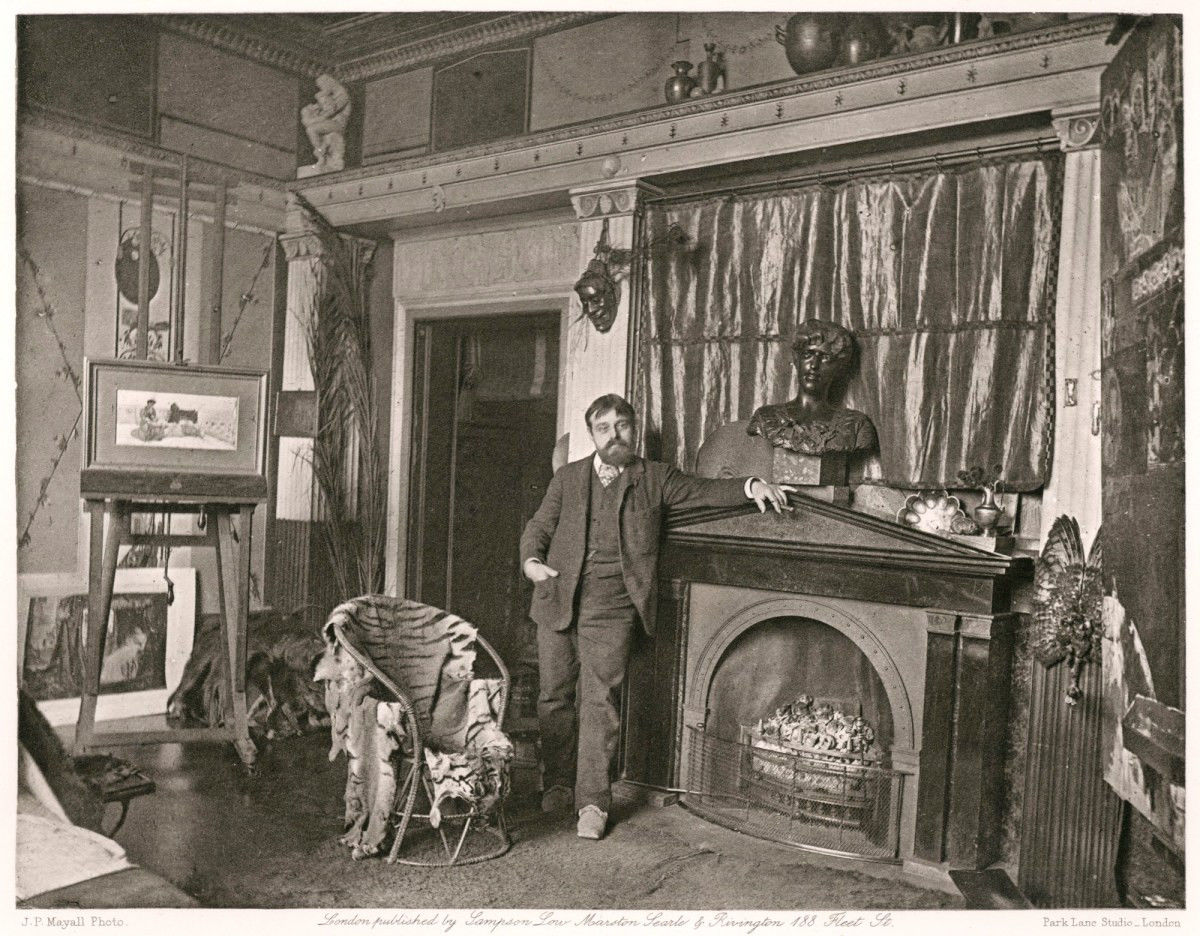
Sei interessato ad acquistare questa opera d'arte?
Artwork details
Related artworks
- 1 - 4 / 12
- 1 - 4 / 24
Willem Witsen
Waiting carriages in front of Waterloo Bridge1850 - 1900
Prezzo su richiestaKunsthandel Pygmalion
Jan Voerman sr
Still Life with flowers in a Chinese figurine1850 - 1900
Prezzo su richiestaKunsthandel Pygmalion
Jan Sluijters
Original illustration of Sluijters for the book: 'Laura's opstel'1881 - 1957
Prezzo su richiestaKunsthandel Pygmalion
Carel Nicolaas Storm van 's Gravesande
View on Venice1841 - 1924
Prezzo su richiestaKunsthandel Pygmalion
1 - 4 / 24- 1 - 4 / 7
Rene Rietmeyer
"PORTRAIT OF YAYOI KUSAMA JUNE 1999"1999
Prezzo su richiestaEuropean Cultural Centre Collection
1 - 4 / 24Walter Francia
Large painting WF/2013/01 Title Unicum (40) 2013
Prezzo su richiestaGallerease Selected
1 - 4 / 12












